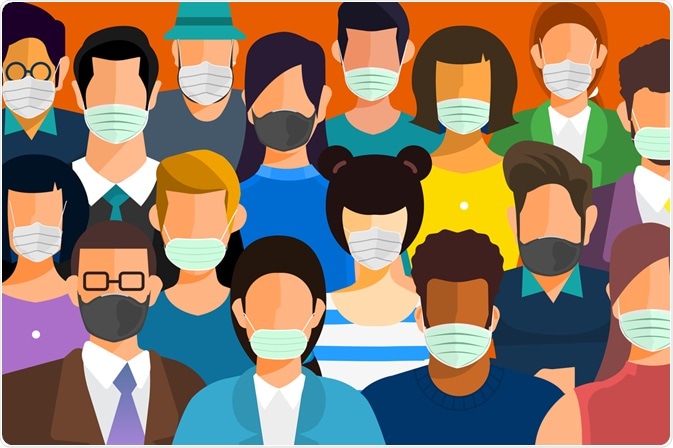The emergence of the severe acute respiratory syndrome coronavirus 2 (SARS–COV-2) virus in Wuhan, China, in 2019 and the subsequent coronavirus disease 2019 (COVID-19) pandemic has been linked to the anthropogenic biodiversity crisis and climate change.
The disturbance or destruction of the natural environment through human activity has resulted in a loss of biodiversity. Consequent to these actions, deadly diseases emerge as human-animal relations are destabilized, or novel associations are established, thus enabling viruses to cross over and jump the species barrier.
 Image Credit: emojoez/Shutterstock.com
Image Credit: emojoez/Shutterstock.com
Hotspots for biodiversity
Villagers in Northern Gabon found themselves at the epicenter of a novel viral outbreak in 1996 with the emergence of the Ebola virus. Several native villagers had ventured into a nearby forest and slain a chimpanzee for food. Those who ate the chimpanzee meat quickly became severely ill.
Deadly microbial diseases are now known to be emergent in biodiversity hotspots, including tropical rainforests and bushmeat markets. This accounts for the prevalence of diseases such as Ebola and Middle Eastern Respiratory Syndrome (MERS) Coronavirus in African and Asian cities. Previously, researchers thought the reason could be the plethora of exotic wildlife within a concentrated habitat. More recently, researchers have attributed the problem to the human destruction of biodiversity.
The decimation of biodiversity creates the perfect conditions for new viruses and diseases to emerge as drastic changes occur at the interspecies frontier. As humans invade tropical rainforests and wild landscapes, cutting down trees, logging, mining, building roads, and hunting wild animals, they encounter many species of animals and plants and as a corollary novel microbial life.
The destruction of natural habitats is the main driver of decreasing biodiversity. However, the disruption to the ecosystem is also a consequence of climate change. The climate emergency means life on the planet is drastically altered, leading to rises in species extinction and human entry into biodiverse areas hitherto unchartered. Climatic changes force species to change their geographical range and move habitats to survive, and sometimes this brings them closer to human dwellings.
Animal reservoirs
Increasing human-animal interaction harbors the potential to encourage zoonotic transfer, thus enabling certain viruses to jump the species barrier. Bats are a known reservoir for several such viruses, including Severe Acute Respiratory Syndrome (SARS) Coronavirus 1, Ebola virus, Middle Eastern Respiratory Syndrome (MERS) Coronavirus, Nipah virus, and Hendra virus. The bats themselves are asymptomatic in the face of these viruses, which are only pathogenic to humans and other animals.
As well as habitat destruction, global trade in wildlife trade is also implicated in the potential for zoonotic viral transfer. The same effects are replicated when animals are brought into unnatural proximity with one another as occurs in wet markets ––for example, in Wuhan, various species, including bats, pangolins, and other animals, are kept close to one another in crammed conditions.
The symbiotic relationship of bats and novel viral species is thought to occur due to an immune adaptation. During flight a high and prolonged metabolic increase occurs, leading to elevated levels of free radicals, amongst other things. Rather than triggering an adverse immune response, sustained flight and concomitant the heightened metabolic response instead confers protective effects upon the bat.
Bats harbor viruses that infect the human host. A well-known example is that of genus Lyssavirus, family Rhabdoviridae, which causes Rabies. Direct infection is fortunately rare. The virus needs direct contact with nerve cells, and so the only means of infection is via a deep enough bite. In other cases, an intermediate host is implicated, for example, pigs and horses in the case of Nipah virus.
Biodiversity and #COVID19
A clarion call for historians
Historians have been called upon to understand better the lessons learned from past outbreaks. Still, a comparison of the historical cases kind of prescription is not necessarily what is needed here. Rather the role of historians becomes critical to fostering our understanding of the relationship between the illness of the planet (through the reduction of biodiversity and the effects of climate change) and that of humans. The emergence of the SARS–COV-2 virus was not a bolt out of the blue; this virus has a pre-history.
Historians can help shed light on the long history of human interactions with animals, such as the pangolin which has been investigated in relation to the SARS–COV-2 virus. Historians can study and reflect upon the historical structures of colonization, the rise in globalization and capitalism, geographical evolution, and patterns of settlement. This will enhance our understanding of differing patterns of human engagement with nature and with animals according to patterns of inequality ––for example, the bushmeat trade across Africa is linked to global poverty.
A new discipline, Planetary Health, is currently emerging. Here, the focus is placed upon the increasingly visible connections between human health (and that of other living beings) and the planetary ecosystem. The biodiversity and climate change crises have been brought into sharp relief in the wake of the COVID-19 pandemic. The task facing us all now is a need to focus attention on solutions and measures to confront these challenges.
References
[Futher reading: Coronavirus Disease COVID-19]